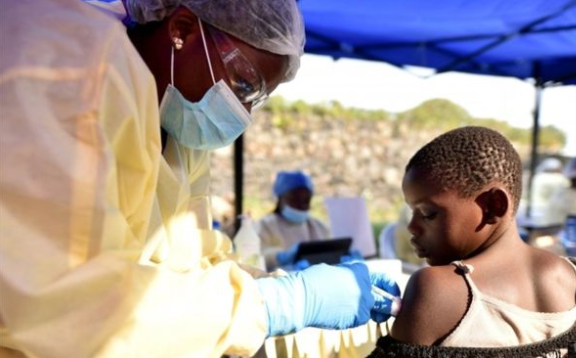A second case of Ebola has been detected on Democratic Republic of Congo’s border with Rwanda, raising fears the deadly illness could spread.
The case was confirmed in the city of Goma, home to two million people, authorities said.
More than 1,600 people have died of Ebola in DR Congo since the outbreak began in August 2018.
The World Health Organization last week declared the crisis a global health emergency.
It is the highest level of alarm the WHO can sound and has only been used four times previously – including the Ebola epidemic that devastated parts of West Africa from 2014 to 2016, and killed more than 11,000 people.
What is the situation in Goma?
Ebola is affecting two provinces of Congo – North Kivu and Ituri. Goma is the capital of North Kivu and lies just across the border from the Rwandan city of Gisenyi.
A priest in Goma died from Ebola earlier this month. The WHO called it a “game-changer”, but until now there had not been any further confirmed cases.
On Tuesday, Dr Aruna Abedi – who is co-ordinating the response to the illness in North Kivu – told AFP news agency he had been informed of a second case.
“All measures have been put in place so that the case is taken care of in Goma,” an official statement said.
The area is densely populated and there are fears this could spread the illness into Rwanda.
Although the country as yet has not had any confirmed cases, it has set up an Ebola treatment centre and is preparing 23 isolation centres in case of any infections.
“But as long as the outbreak continues in the Democratic Republic of the Congo, there is a very real risk of spread to neighbouring countries.”
How bad is the situation in DR Congo?
More than 2,500 people have been infected and two-thirds of them have died.
It took 224 days for the number of cases to reach 1,000, but just a further 71 days to reach 2,000.
About 12 new cases are being reported every day.
Isn’t there a vaccine?
Yes.
It is 99% effective and more than 161,000 people have been given it.
However, everybody is not vaccinated – only those who come into direct contact with an Ebola patient, and people who come into contact with them.
The vaccine was developed during the epidemic in West Africa and has been available throughout the latest outbreak.
Why hasn’t the outbreak been brought under control?
Tackling the disease has been complicated by conflict in the region.
Since January, there have been 198 attacks against healthcare workers or Ebola treatment facilities leading to seven deaths and 58 injuries.
Another major problem has been distrust of healthcare workers leading to about a third of deaths being in the community rather than at a specialist Ebola treatment centre.
It means those people are not seeking treatment and risk spreading the disease to neighbours and relatives.
There has also been difficulty tracking the spread of the virus.
Is the world doing enough to help?
The WHO has been clear for months that it has insufficient money to tackle the problem.
It had estimated that it needed $98m to tackle the outbreak between February and July. Yet it faced a shortfall of $54m.
What is Ebola?

- Ebola is a virus that initially causes sudden fever, intense weakness, muscle pain and a sore throat
- It progresses to vomiting, diarrhoea and both internal and external bleeding
- People are infected when they have direct contact through broken skin, or the mouth and nose, with the blood, vomit, faeces or bodily fluids of someone with Ebola
- Patients tend to die from dehydration and multiple organ failure

